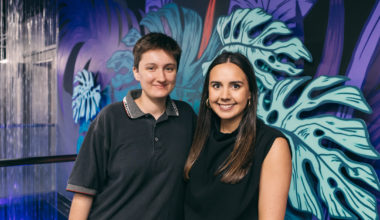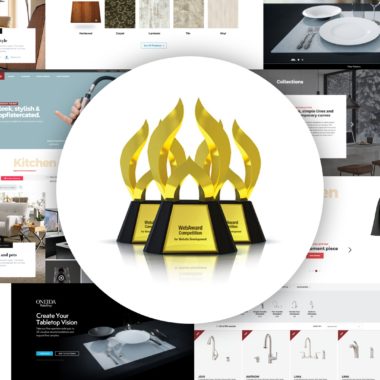Redefining boundaries with interactive experiences
Immersive, interactive experiences are in high demand, especially when it comes to digital. We sat down with Jenny Koeppel, Director of Front-end Development, and Scott Deca, Sr. Visual Designer, to discuss what an interactive experience means from both a development and design perspective.
Sally: Thanks for sitting down with us today, Jenny, and Scott. I want to start by asking how you would both describe or define an interactive experience in your own words?
Jenny: To me, an interactive experience as it relates to digital media is something that engages a user mentally and visually. The experience should pique a user’s interest, involve movement, and take the user on a journey. It should inform and entertain.
Scott: I would describe it as any experience that focuses on whatever a specific person is looking for—whether it’s gathering information, satisfying general curiosity, shopping for products, browsing for entertainment—and delivers it in an adaptive way that meets their needs. That’s what separates it from a static experience such as printed materials: it can change shape, becoming more simple or complex as needed.
Sally: Great, thank you both for diving straight in. So Jenny, what are the components of an interactive experience from a development perspective?
Jenny: From a development perspective, the components involved are:
- Inform the user: have meaningful content to deliver your message
- Engage: visual design and layout / UX / UI / motion and movement
- Performance: choosing the right framework and architecture to meet needs
Sally: Scott, What are the components of one from a design perspective?
Scott: From a design perspective, the main component is seeing it through the lens of the user. This context guides how we prioritize the typical design components. Other questions to consider are:
- Is this a marketing website geared at funneling people to relevant products? Then aesthetics, wayfinding, and imaginative messaging will play a bigger role.
- Is this an internal resource management platform? Then accessibility, internal user testing, and rational design systems will be more important.
Those are helpful considerations. So how can a business truly transform its brand with an interactive experience?
Jenny: Technology has come so far. Gone are the days of flat digital experiences where you’re constantly scrolling and reading. Now we have so many opportunities to involve multiple dimensions and movements that deliver a more exciting brand personality.
Scott: Businesses will always be fighting to stand out in their audience’s mind—there are more options every day and customers are inundated with that fact anytime they begin a new search for something they’re unfamiliar with. A business with a successful interactive experience will both win over new customers who directly interact with it, but also gain momentum through word-of-mouth as users share their experience.
Sally: I think those points are really helpful for understanding the fundamentals. Going a bit further, what are some ways an interactive experience can “redefine boundaries” for a business?
Jenny: Businesses have so many more ways to reach their audiences now. Emails, websites, apps, games, promotions—all of these are ways businesses can now show their personality and reach their users. They can be in constant communication with their consumer which helps fuel their success.
Scott: There are always new ways to take advantage of evolving technologies. Becoming an early adopter of these can be risky from a business perspective, but the payoff is that your brand will move into a smaller “pond” that will be easier to stand out in (within consumer’s mindsets). In this way, a business can either become more memorable or even shift which audiences are drawn to that business.
Sally: What advice would you both give to a business that wants to invest in an interactive experience? Where would you suggest they start?
Jenny: Find a partner with experience in creating digital experiences from the ground up. Work together with them to figure out your goals. Go into the experience with an open mind and listen to their advice. The world of digital can be complex and confusing and you need an expert for guidance.
Scott: I would suggest they start with introspection into who they’re trying to reach and what platforms impact that audience the most. You can make a beautiful experience, but if it’s not reaching the right people or solving a real problem for them, then it’s likely that it’ll just be more clutter in their online experience. And if they’re not sure which platforms, then it’s time for some surveys and audience research (and a digital partner to help you sort through it all, like Jenny mentioned).
Sally: Jenny, as a developer, what components are involved in creating an interactive experience? What trends are you seeing?
Jenny: People want highly engaging, unique experiences that are quick to respond and simple to interact with. You need to keep up with the latest and greatest front-end frameworks to support constant change. Movement towards data and presentation layer separation has become a key component in today’s digital architecture.
Sally: Scott, As a designer, what components are involved in creating an interactive experience? What trends are you seeing?
Scott: Standing out amongst competitors is always key, and right now that means novel design and experiences. Three trends at the moment include breaking the typical grid format, hijacking expected web browser interfaces, and exploring what’s possible with new mobile phone technologies.
Breaking the grid helps an experience feel less “canned”—built on a CMS with pre-defined layouts that you see on hundreds of other sites. This often translates to an experience feeling more authentic or well crafted: something that took time and care to make. Hijacking the way a web browser works is often debated by UX / UI experts, but when done in small amounts, can make for a unique experience or even a moment of delight (when it works). Examples of this include replacing the default cursor with a custom animated one, or changing the direction a webpage scrolls. Lastly, companies like Ikea, Etsy, and Houzz are taking advantage of AR to enable users to see products within their own space. Visualization has been around for a long time, but is definitely on the rise again with improved technologies like lidar and AI-powered image recognition.
Sally: Thanks for talking to us, Jenny and Scott! If your business or brand is considering developing an interactive experience and is seeking a digital partner, contact us!
Image credits: Johnny Brown, Sindy Süßengut





